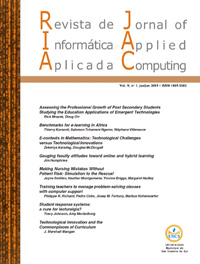Benchmarks for e-learning in Africa
DOI:
https://doi.org/10.13037/ria.vol5n1.366Keywords:
Open and Distance Learning, Graduation Rates, Student MotivationAbstract
This presentation begins by addressing the issue of effective open and distance learning (ODL) and then outlines the conditions for effectiveness and their impacts on student motivation and persistence. Despite the many studies showing that graduation rates for open and distance learning are between 20% and 45%, the strategies implemented by the University of Montreal team have resulted in over 90% graduation rates from demanding university programs. This presentation aims to provide a greater understanding of the strategies liable to foster successful open and distance learning in Africa.Downloads
References
BECKER, H.J. Internet Use by Teachers. Irvine (CA): University of California, 1999.
BIALO, E.R. Report on the Effectiveness of Technology in Schools - 1990-1992. Washington (DC): Software Publishers Association, 1993.
BOSHIER R., MOHAPI, M., MOULTON, G., Qayyum, A., Sadownik, L., & Wilson, M. Best and worst dressed web courses: Strutting into the 21st century in comfort and style. Distance Education - An International Journal 1997; 18: 36-49.
CHICKERING, A., & REISSER, L. Education and identity. San Francisco: Jossey-Bass, 1993.
CHICKERING, A., & GAMSON, Z. Seven principles of good practice in undergraduate education. AAHE Bulletin 1987; 39: 3-7.
CLARK, R.E. Media Will Never Influence Learning. Educational Technology, Research and Development 1994; 42: 21-29.
CLARKE, D. Getting Results with Distance Education. The American Journal of Distance Education 1999; 12: 38-51.
DECI, E.L., & Ryan, R.M. Self-Determination Theory and the Facilitation of Intrinsic Motivation, Social Development, and Well-Being. American Psychologist 2005; 55: 68-78.
DEPOVER, C., GIARDINA, M., & MARTON, P. Les environnements d'apprentissage multimedia. Paris: L'Harmattan, 1998.
EHRMANN, S.C. Asking the Right Question: What Does Research Tell Us About Technology and Higher Learning? Change, 1995; 27: 20-27.
GAUTHIER, P.D. La face cachée de la e-formation. ThoT, 2001.
GOLDBERG, M.W.C. First Results From an Experiment in Computer-Aided Learning. Proceedings of the ACM's 28th SIGCSE Technical Symposium on Computer Science Education, 1997.
GOVERNMENT OF CANADA. Un Canada.branché. Ottawa: Government of Canada Publications, 2000.
GRAHAM, C., CAGILTAY, K., CRANER, J., LIM, B., & DUFFY, T.M. Teaching in a Web-based distance learning environment: An evaluation summary based on four courses. Center for Research on Learning and Technology Technical Report No. 13-00, Bloomington, IN. 2000.
HAUGHEY, M., & ANDERSON, T. Networked Learning: The Pedagogy of the Internet. Toronto: McGraw-Hill, 1999.
HIGHER EDUCATION PROGRAM AND POLICY COUNCIL. Distance Education: Guidelines for Good Practice. HEPPC: Washington, D.C., 2000.
HOWE, S.E. (Ed.). High Performance Computing & Communications and Information Technology Subcommittee: Toward a National Information Infrastructure. Washington, D.C.: Office of Science and Technology Policy, 1994: 205-206.
INSTITUTE FOR HIGHER EDUCATION POLICY. Quality on the line: Benchmarks for success in internet-based distance education. Washington, D.C., 2000.
INSTITUTE FOR HIGHER EDUCATION POLICY. Quality on the line: Benchmarks for success in Internet-based Distance Education. IHEP: Washington, D.C., 2001.
INTERNATIONAL DISTANCE EDUCATION CERTIFICATION CENTER DISTANCE EDUCATION STANDARDS: Principles for Designing and Delivering Quality Distance Education Courses. IDEC: Washington. D.C., 2001.
JACOBSON, M.J.S., & SPIRO, R.J. Hypertext Learning Environments, Cognitive Flexibility, and the Transfer of Complex Knowledge: An Empirical Investigation. Center for the Study of Reading, Technical. Report #573, OERI, 1993.
JONASSEN, D.H., HOWLAND, J., MOORE, J., & MARRA, R.M. Learning to solve problems with technology: A constructivist perspective, 2nd. Ed. Columbus, OH: Merrill/Prentice-Hall, 2003.
JONASSEN, D.H., & WANG, S. Acquiring Structural Knowledge from Semantically Structured Hypertext. Journal of Computer-Based Instruction 1993; 20: 1-8.
JONASSEN, D.H. Computers as Mindtools for Schools: Engaging Critical Thinking. Columbus, OH: Prentice-Hall, 2000.
KARSENTI, T., & LAROSE, F. Les TIC …Au cÅ“ur des pédagogies universitaires. Québec: Presses de l'Université du Québec, 2001.
KARSENTI, T. Favoriser la motivation et la réussite en contexte scolaire: Les TIC feront-elles mouche? Vie pédagogique 2003; 127: 27-32.
McALPIN, V.F. On-line and Face to Face Students: Is there really any difference? Proceedings: 2nd UNC Workshop on Technology for Distance Education. North Carolina State University, 1998: 6-7.
OECD (2006). La cyberformation dans l'enseignement supérieur.
OECD (2001). L'école de demain. Paris: Centre pour la recherché et l'innovation das l'enseignement.
PERRENOUD, P. Se server des technologies nouvelles. Genève: Faculté de psychologie et de sciences de l'éducation, Université de Genève, 1998.
PROCTOR, J.D., & RICHARDSON, A.E. Evaluating the Effectiveness of Multimedia Computer Modules as Enrichment Exercises for Introductory Geography. Journal of Geography in Higher Education, 1997; 21: 41-55.
RUANO-BORBALAN, J.C. Risques et promesses de l'e-éducation. Sciences humaines 2001; (32): 44-47.
RUSSELL, T.L. The No Significant Difference Phenomenon. North Carolina: NCSU Office of Instructional Telecommunications, 1999.
SANDHOLTZ, J.H., RINGSTAFF, C., & DWYER, D.C. Teaching with Technology - Creating Student Centered Classrooms. New York: Teachers College Press, 1996.
SCHUTTE, J.G. Virtual Teaching in Higher Education: The New Intellectual Superhighway or Just another Traffic Jam? California State University Electronic Journal of Sociology, 1997 [On-line]. Available at: http://www.csun.edu/sociology/virexp.htm
TARDIF, J. Intégrer les nouvelles technologies de l'information: Quel cadre pédagogique? Paris: ESF Éditeur, 1998.
TÉLÉ-ÉDUCATION NOUVEAU-BRUNSWICK. The Design, Development and Delivery of Internet Based Training and Education. Télé-Éducation NB: Nouveau-Brunswick, 2000.
UNGERLEIDER, C. Information and Communication Technologies in Elementary and Secondary Education. Toronto: Council of Ministers of Education, Canada, 2002.
ZIRKIN, B.G., & SUMLER, D.E. Interactive or Noninteractive? That Is the Question!!! An Annotated Bibliography. Journal of Distance Education 1995; 10: 95-112.
Downloads
Published
Issue
Section
License
Copyright (c) 2010 Thierry Karsenti, Salomon Tchameni Ngamo, Stéphane Villeneuve

This work is licensed under a Creative Commons Attribution-NonCommercial-ShareAlike 4.0 International License.
Os autores que publicam trabalhos na RIA estão de acordo com os seguintes termos:
- Autores mantêm seus direitos autorais e concedem à RIA o direito à primeira publicação. Admite-se o compartilhamento do referido trabalho, desde que seja reconhecida sua autoria e publicação inicial nesta revista.
- Autores podem fechar contratos adicionais separadamente, para distribuição não exclusiva da versão do trabalho publicado na RIA, com reconhecimento de sua autoria e publicação inicial nesta revista.
- Autores podem publicar e distribuir seu trabalho online, antes ou durante o processo editorial.


